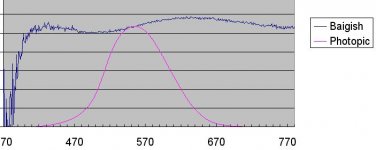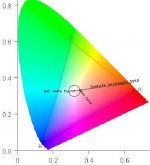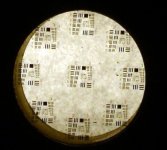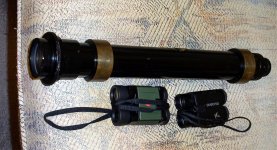Strangely the 12x50 bins were bought on Ebay at the BIN price of $29.95 + $16.95 shipping because they usually got to nearly that price anyway. I mentioned that they came in a really inexpensive Bresser carry case inside the box, so perhaps the Bresser 10x50s you get so inexpensively are also Russian.
Being one who firmly believes that you get what you pay for, ksbirds/foxranch’s comments, as an experienced bino user, about a $30 +$16 S&H decent porro intrigued me.
A few days ago I received a Baigish 12x50 porro prism binocular that was mentioned by ksbird/foxranch. I just could not resist the temptation. I like 12x50 far more than the 10x offerings and was curious how this would compare to my beloved 12x50 BN’s.
The data that came with the binos was:
12X
92m/1000m FOV
19 mm Eye Relief
4.17 mm Exit Pupil
192x175x60
0.9 Kg. mass
First of all, some of the technical, non-subjective stuff.
The collimation was within the appropriate tolerances, but just barely. The horizontal is about as good as it gets, less than 5’ but the vertical is 28’ (30’ ISO). This was measured in image space and there may be an issue with the power, which has not been checked yet.
The measured close focus distance is 9.8 meters.
The weight of the binocular, bare, no straps or lens caps, was 25 ozs. (709 g), listed as 2 pounds. Width is 191 mm at my IPD and length is 178 mm. Instrument appears to be mostly plastic, maybe plastic lenses as well.
The resolution tests were a little strange. I will come back to this later but it seemed that the top part of the image was more out of focus than it should have been. The best figures were 3.2 arc seconds/line pair in the right tube and 3.6 arc seconds/line pair in the left tube. I would occasionally get into small zones that were not this good, being about a group less, about 6”/lp. The ISO limits are 300/aperture=6”/lp. Someone else may do a little better since I was at the limits of my setup, resolving group 7, elements 2 and 3 of the USAF 1951 chart at 400 mm.
CA seemed too good. Even at 60-72x looking at the collimator grid lines, I noticed no color fringing when focusing through the lines. Someone else will have to check this though. I think I have spent the last 45 years learning to ignore CA in higher-powered survey instruments and I am not going to learn to see it again and irritate myself with it at this late date.
There is a very little amount of squaring of the exit pupil apparent and I can only see 46-48 mm of objective aperture with a lens at the exit pupil. I also need to recheck the collimator settings, as the FOV seems to measure 6.7 degrees instead of the 5.3 shown on the instrument (93m/1000m). The view also exhibits a moderate amount of pincushion distortion.
The exit pupils, specified as 4.17 mm, measured 4.8/5.0 mm ???
The eye relief is almost a little short for me. I measured 8 mm from glass to the top of the eyecup and about 12 mm total. The specs called for 19 mm. I had to press my eyes in a little more than usual to get a full view.
Brightness is something less than either the 12x50 Trinovid or the similarly sized exit pupil of the 8x36 Monarch. Math wise, there is about 9% difference in the Monarch’s and Trinovids, though I am hard pressed to see it. The Baigish is noticeably dimmer, even by the simple test of holding up two pair and comparing the exit pupils. The color shift is also noticeable. There is a transmittance curve attached but is to be used for the general shape of the curve. It is not a good calibrated representation of the levels. The color data should be good though. I am not set up to test porro designs with a 30mm offset in the light train and lose calibration when moving the detector over to capture the exit pupil. For me to notice the difference this way, I would assume the Baigish to be at least 10% less than the Monarch and Trinovids.
With the FOV and exit pupil measurements not making sense to me, I went back and measured the magnification level of this bino. Instead of 12x I found a left tube of 9.6x and right tube of 9.5x. This information put the FOV, exit pupils and some questions about the transmission (brightness) issues in a more consistent state. Note that as a 10x50, this bino should have been approximately 20% brighter than the Monarch, a 5 mm exit pupil versus 4.5 mm.
The color presentation through the Baigish is pleasing and close enough to neutral to not be a real issue to me but slightly more red than the Nikons. The contrast is on a par with the Monarchs and just slightly lower than the Trinovids. I have attached the full color file and added a few notes for those who have asked me about this. For reference data, the Trinovids averaged 586.2 nm (255/236) at .129, Monarchs averaged 589.7 nm (255/223) at 0.103 and the Baigish 599.8 nm (255/190) at .098. The numbers in parenthesis are the RGB conversion of the dominant wavelength to average Red/Green value for reference. As can be seen, a lot of how you would perceive the neutrality would depend on how sensitive you are to the red or green components. With all three binos being about 90% white and the small shifts in color only applying to the remaining 10% of the level, it is easy to see how close to neutral they are without direct comparison.
So much for the objective stuff now, to the subjective and the minuses of these binoculars.
Focus is smooth, a little on the stiff side and backwards with a decent speed for my use.
Now for the real minuses. While trying to figure out the apparent zone resolution and focus differences, I took the binos outside for a quick star test. Unfortunately no stars were visible due to a very thin overcast but I had a decent view of the moon. The first thing I noticed was some internal reflections, pretty strong reflections at that. The main one in both tubes seemed to directly related to the objective lens as it stayed in a constant position relative to the target as the moon was moved around in the FOV, 4 o’clock in the right tube and 12 o’clock in the left tube, this one being the weaker of the two. There were also 3 more reflections in each tube of a stepped size that changed alignment and distance from the center with the position of the moon in the FOV. Further investigation showed that the only visible coating on the objective had a green coating but there was a large, bright, white reflection from inside. Looking from the eyepiece side I could see two or three surfaces with a magenta cast, but again, a large bright, white reflection (prism?) deep inside and shows from both ends. I think the aligned reflections may be coming from the prisms. I also think the reflections may have been the cause of the of the bad resolution zones during resolution testing since the grid was backlit and the room pretty dark otherwise.
While moving the moons image around in the FOV I noticed that as you moved the image into the upper or lower part of the view, the image would get taller and narrower while moving to the left or right part of the field the image got shorter and wider. This astigmatism, coupled with a previously noted 2 or 2.5 diopter curvature produced the interesting effect of having a reasonably focused image horizontally across the image while the top and bottom portions were out of focus.
I find these binos to be a good, cheap pair useful for daylight use, well worth the $50 out of pocket. Stargazers or low light users will find them disappointing. I would not feel bad about loaning them to people for daylight use.
At this price, I imagine sample variation could cover a broad range indeed.
I hope this quick, brief review will answer some questions others looking at these binoculars may have.
Best,
Ron








